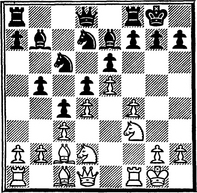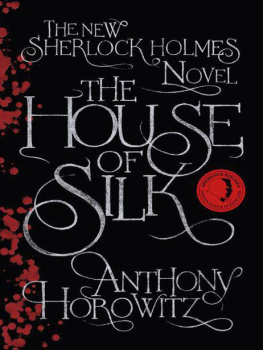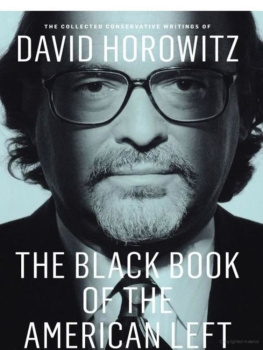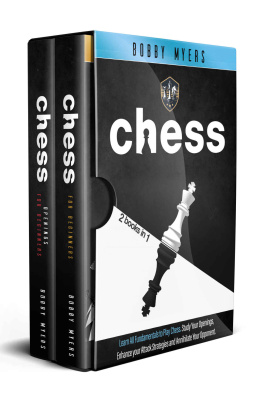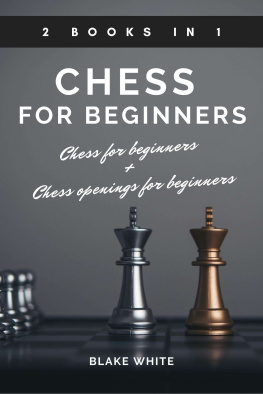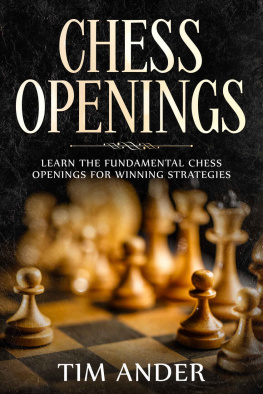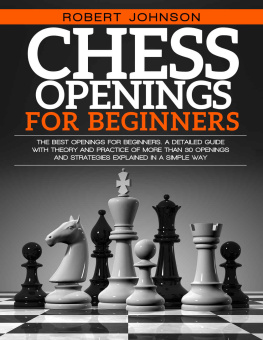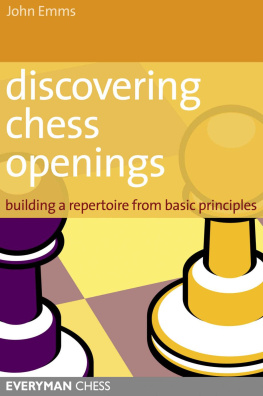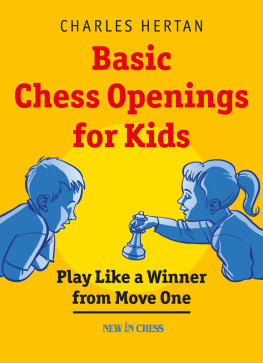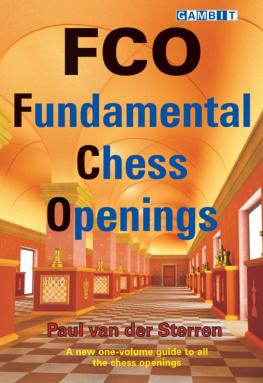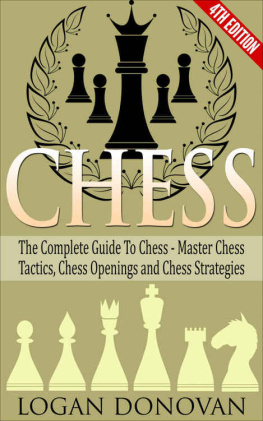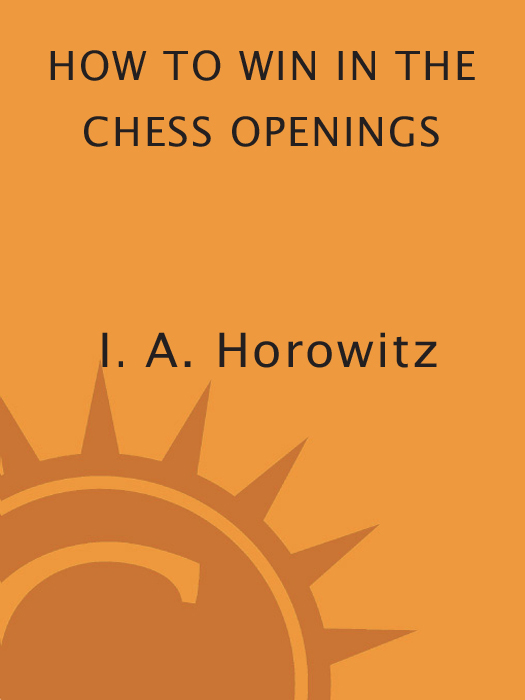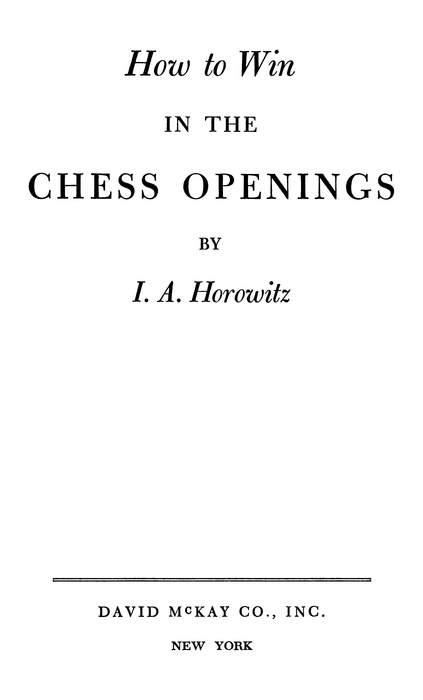COPYRIGHT , 1951,
BY I. A. HOROWITZ
ALL RIGHTS RESERVED, INCLUDING THE RIGHT TO REPRODUCE THIS BOOK, OR PORTIONS THEREOF, IN ANY FORM, EXCEPT FOR THE INCLUSION OF BRIEF QUOTATIONS IN A REVIEW .
eISBN: 978-0-307-82828-6
v3.1
Foreword
E VER since the first game of chess was recordedabout five hundred years ago or moreno less than twenty thousand chess books, written in different languages, have appeared in print. Consequently, every phase of the game has been considered.
Yet here is another book. Why?
In delving through multitudinous works on chess openings, I have come to the conclusion that only one thing is clear. And that is that all is quiet confusion! The reader is required to memorize an opening by rote, is occasionally told via the symbol of an exclamation point or question mark that a move is good, bad or indifferent, and then is left hanging, as it were, in mid air to reason out for himself the whys and wherefores. What part each move plays in the strategic concept of the opening pattern is lightly glossed over or not mentioned at all.
Under the circumstances, there has been room for improvement. In this book, I have, therefore, endeavored to present the study of chess openings in a logical, easy-to-understand manner, not beyond the grasp of the player who has learned little more than the rules of chess. To begin with, I have outlined and discussed the principles and concepts of opening play, common to all openings. Then, in turn, I have taken specifically, each of the most popular openingsattacks and defensesand have broken them down to their individual moves and grand plans. I have tried to show how the tactical forte of each move ties up with the strategical idea. Lastly, I have appended to each opening a classic, over-the-board, example from actual play in movie style.
For those unfamiliar with the term chess movie, I wish to point out that it is no more than a chess game, recorded by a series of diagrams. The numerous diagrams make for clarity as well as ease of study. For the movie obviates the use of a chessboard and men, as the game can be followed from the text.
In closing, I wish to give a word of caution: gaining an advantage in the opening brings victory in the endgame. I must confess, however, that the title has given me a pang of conscience. What I really ought to call the book is How to Understand the Chess Openings. Most players, however, are not interested in understanding; they only want to win. Hence the title. It is clear that with understanding will come many victories.
I. A. H OROWITZ
Contents
The original position from which the opening springs is the most difficult of the entire game. For here thirty-two potent units are animated and unleash a vast power.
Principles of Opening Play
T HE game of chess is divided into three partsthe opening, the middle game and the endgame. The divisions are purely arbitrary, merely for the purpose of facilitating study. No dividing line separates the parts; the transition from the opening to the middle game and from the middle game to the endgame is indicated by the action and the number of men remaining on the board.
The opening covers approximately the first twelve moves of the game, with all or most of the pieces on the board. The middle game is characterized generally by the presence of Queens; the endgame is greatly simplified, with few of the forces remaining.
The opening is a development of forces. It begins with the first move and ends with the mobilization of nearly all of the men. The Rooks, as a rule, are the last to enter the skirmish, and often do not participate in the play until well into the middle game.
TYPICAL OPENING POSITIONS
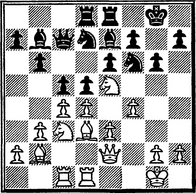
Queens Gambit Declined with Rooks developed.
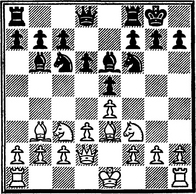
Giuoco PianoWhites Rooks not yet moved.
Ultimate Goal vs. Opening Goal
In order to understand the mechanics of the opening, it is necessary to know the opening goal. While checkmate is the principal goal of the game, it is subordinated in the opening, since the pieces are just beginning to get out. Of course, if the opponent plays very badly, or exposes his King critically or neglects his development glaringly, then checkmating ideas come to the forefront. With reasonably correct play by both contestants, lesser objectives are the goal. These all tie in with the prime purposecheckmate of the opponents King. Checkmate is the ultimate goal.
Try for Small Advantages
Opening play can contribute towards the checkmating goal in a minor way. Essentially, it can do so by laying a sound foundation for the middle and endgame; by gaining small positional and material advantages. Many small advantages add up to a large plus.
EXAMPLES OF RATIONAL AND IRRATIONAL DEVELOPMENT

Ruy LopezRational development on both sides. Checkmate is a consideration far in the future.
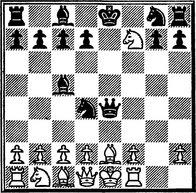
Ruy Lopez N-B6 mate. Violations of opening principles have brought a sudden end.
What is a sound foundation and what are the small advantages? The answers to these questions shed light on the function of opening moves.
A sound foundation is one which is free of structural weaknesses, weaknesses which require attention or which undermine anything built upon them. As the foundation pertains only to Pawns, the subject is better treated in a discussion of the endgame. Insofar as the foundation affects the opening, however, a limited discussion will appear later on.
More to the point is the question of small advantages. What are they?
There are two types of advantage in chess. One is positional; the other material.
Positional advantage is the plus which derives from the ability to control squares, vital for immediate or future action, as well as from the sounder Pawn structure. Superior mobility and command of greater terrain augment the advantage.
Control of the Center
While the opening is concerned with every conceivable advantage, emphasis is generally placed on the control of important squares. In the absence of outright blunders ceding material, the initial goal is the gain of squares.
EXAMPLES OF POSITIONAL ADVANTAGE
